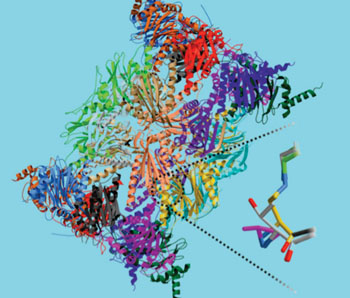Drug Development Advance for Treatment of Autoimmune Diseases, Chronic Inflammation Disorders
By LabMedica International staff writers
Posted on 08 Oct 2014
The immune system functions as the body’s protectors, defending it from intruders such as bacteria and viruses. However, to ascertain what is happening in the cell, the immune system requires information on the foreign invaders. This chore is taken on by protein complexes called immunoproteasomes. These are cylindrical complexes break down the protein structures of the intruders into fragments that can be used by the defense system. Biochemists in Germany have now discovered a way to suppress its functionality, thereby laying the foundation for possible enhancements of existing drugs.Posted on 08 Oct 2014
“In autoimmune disorders like rheumatism, type 1 diabetes, and multiple sclerosis or severe inflammations a significantly increased immunoproteasome concentration can be measured in the cells,” explained Prof. Michael Groll, from the department of biochemistry at Technische Universitaet Muenchen (TUM; Germany). “The deactivation of this degradation machinery suppresses the regeneration of immune signaling molecules, which, in turn, prevents an excessive immune reaction.”

Image: Crystal structure of the immunoproteasome (Photo courtesy of the department of biochemistry, TUM).
Scientists have vigorously been searching for new active substances that suppress immunoproteasomes in a targeted way without inhibiting the constitutive proteasomes that are also present in cells. Constitutive proteasomes degrade defective or no longer required proteins and are thus responsible for cellular recycling. Notably cell death occurs, when both the constitutive proteasomes and the immunoproteasomes are inactivated.
In early 2012, researchers led by Dr. Groll fulfilled a prerequisite for designing specific active substances: they deciphered the crystal structure of the immunoproteasome, allowing them to target the slight but significant differences between the otherwise almost identical structures. The potential drug that the researchers developed is based on the epoxyketon ONX 0914, an immunoproteasome inhibitor that is undergoing clinical trials. The researchers replaced the epoxyketon with a sulfonyflouride group and changed its positioning on the inhibitor. The result was a new compound that selectively blocks the immunoproteasome without influencing the constitutive proteasome.
First author Christian Dubiella clarified what makes the discovered process so distinctive: “Normally, inhibitors clog up the active center of the enzyme and thereby disable its functionality. The substance synthesized by us, however, attaches to its target, causing the active center to destroy itself, and then gets detached after successful inactivation.”
Using X-ray structure analysis, clues into the atomic mechanisms were discovered, paving the way for personalized development of immunoprotease inhibitors, thus helping develop a future generation of drugs, according to the scientists.
The study’s findings were published online September 22, 2014, in the journal Angewandte Chemie International Edition.
Related Links:
Technische Universitaet Muenchen













